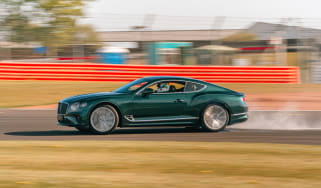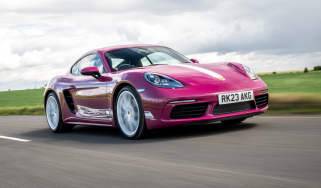Bentley Continental GT W12 (Mk1, 2003-2010): the car that saved Bentley
The Bentley Continental GT is now exclusively hybrid V8-powered. We revisit the original W12, the car that changed Bentley forever
Changing times in Crewe. The fourth-generation Bentley Continental GT adopts a 770bhp+ plug-in hybrid V8 powertrain and is the next step on Bentley’s stated mission of a fully electrified line-up at the end of the decade. Meanwhile, it’s goodnight from the Crewe firm’s famed W12 engine. The big, smooth, distinctive powerplant has been synonymous with big, smooth, distinctive Bentleys since 2003, when it powered the original Continental GT.
W12 production ended in April, after more than 100,000 of the four-bank, 6-litre units had been built at Bentley’s Crewe factory, with production of 4-litre V8 Continentals and Flying Spurs ending soon after.
> New Bentley Flying Spur goes ‘Ultra Performance Hybrid’ with 771bhp
A timely moment, then, to bid farewell to one of the automotive world’s most singular powerplants by revisiting the car the W12 first found a berth in: the original Bentley Continental GT. And, as the new Conti GT prepares for launch, a timely moment to acknowledge just what a pivotal car the original has been for Bentley.
It’s a real before-and-after car, a watershed moment for the brand. A different audience; vastly increased sales; a whole new automotive market segment. The reason Bentley is in rude financial health right now – perhaps, even, in existence at all – is down to this car.
Meeting it outside Bentley’s Crewe factory, its contemporary rounded noughties coupe volumes are instantly recognisable. It’s on the cusp between olde worlde Bentley, with its chrome details and design themes referencing the original R-Type Continental, and the marque’s modern era.
Although other body styles were considered, the decision was taken to make the first new-era Bentley a two-door coupe (partly, one senses, by the need to differentiate from Rolls-Royce).
The Conti GT needed to have the styling, and driving dynamics, to turn the heads of established grand tourer and supercar owners, but a sense of luxury and refinement to give the car something of a USP – and remain true to the established Bentley ethos.
Settling into its cabin, it feels more dated than I’d expected: in my head the Conti GT is still a relatively recent car but, time being the silent thief that it is, it’s now 20 years old. It feels it – not in terms of its condition, this particular car is immaculate – but in the shiny, slightly slippy leather seats; the pre-smartphone mobile holders integrated inside the centre armrests; the green ’n’ cream two-tone colour scheme; the TV option for the screen mid dash, complete with Teletext button.
With plenty of wood and chrome adorning the relatively upright dash, but a modern, plunging twin-cowl shape that’s still echoed in the current Conti, it too is a bridging gap between ultra-traditional Bentleys of old and its new-era model line-up. A touch dated today it might be, but it’s still an evocative environment to sit in. It has that ground-level-private-jet, let’s-drive-direct-to-the-Med essence.
Start the engine and it settles into a smooth idle with a deep note. Rather than a traditional three-bank W12 aero engine, VW’s four-bank design is, in essence, two ultra-narrow-angle 15-degree V6s joined at a common crankshaft. It’s almost like a very beefy V12, with a 72-degree angle between the two V6 elements.
Prior to the Conti GT, it had been used to power a series of Volkswagen supercar concepts (including to a series of speed records at Nardo in 2001), an Audi A8 variant and the overengineered, under-the-radar VW Phaeton. The latter with which some of the Continental GT’s components were shared, though there’s less in common between the two cars than popular pub chat suggests. But it was in the Bentley that the twin-turbo W12 found its true calling.
Though not quite as smooth as a V12, it’s usefully smaller (occupying around 24 per cent less space than an equivalent-capacity V12). That helps the packaging requirements of all-wheel-drive – an attribute it was decided the Conti GT needed from the get-go, along with a target top speed approaching 200mph and a 0-60mph under five seconds.
Today, it doesn’t feel hugely quick by warped modern standards but it can certainly still get a move on. There’s oodles of torque, available readily from only 1600rpm, giving the W12 a very tractable feel. A charismatic one, too. Its burly nature gives the Conti GT a little of that heavy-industry feel and suits its muscular character.
Over the years, the W12 was continually fettled by Bentley, with power increasing by 37 per cent and torque by 54 per cent, and emissions reducing by a quarter. For the Bentayga SUV’s launch in 2015, the W12 was redesigned from the sump up, with a stronger crankcase, slipperier cylinder surfaces, a revised fuel injection system and cylinder deactivation tech, among many other changes. Bentley has given the W12 a send-off by creating the most powerful version of all for the limited-run, 18-off Batur special model, with 740bhp and nearly 740lb ft.
The air suspension (with two ride height settings, and four damper modes) gives the GT a smooth ride, if a slightly wallowy one, although small bumps still thump through the car. It feels less torsionally rigid than a modern Continental, accentuated by some audible creaking from the door trim while cornering, and it feels less precise than its modern equivalent.
You find yourself working away at the (lovely, hydraulic) power steering a fair bit, as if you’re Barnato or Birkin. A lot of that steering you’re putting in is counteracting the suspension’s movement more than dictating the Continental’s path around the corner.
As the miles tick on, you learn to trust it and work around it, starting the corners early, to account for the weight and suspension movement. It’s part of the car’s character and you can cover ground swiftly. It has an awful lot of grip, both in terms of lateral grip and longitudinal traction. The out-of-shape photo took extreme provocation, and this is a car with very safe handling.
It does feel a very heavy car, however; after all, the kerb weight is around the 2.3 tonne mark. And it still has heavyweight star appeal, 20 years on. When we stop for static photos, a car spots us, stops and its driver comes up for a chat. He’s enamoured with the Bentley, and asks all kinds of questions about it. ‘I bet you can hear the clock ticking at 100mph,’ he enthuses. In actuality, the W12 has a rumbly, wooffly soundtrack that’s actually quite vocal on the move.
This car had A-list appeal at launch too, famously. The Conti GT levelled Bentley up from hand-built to mass-production – and a whole new world of sales volume. These days the Bentayga is the volume seller for Bentley, not the Continental GT, but the Conti is still an image-builder and flag-bearer for the brand.
If Bentley hadn’t changed with the times, who knows what shape it would be in today. And perhaps we’re at a similar moment in time, where the company can’t afford to stand still.
Insight: Chris Cole, Bentley line director
‘We sometimes refer to it as the second revolution of Bentley. The first one, really, being the success of the Blowers at Le Mans. The reason we say that is because although Bentley made some great cars in the long period between the Blowers and VW acquiring the company in 1998, with the synergies and arrangements with Rolls-Royce and different owners through the decades, we sort of fell to the wayside.
‘Some people thought a Bentley was like a version of a Rolls-Royce rather than a brand in its own right. The Continental GT allowed a complete separation from that and allowed us to breathe as a brand.
‘We had lots of debates about what [product] we should go with first, for the first 12 months into VW ownership – what that needed to be and how it could help position Bentley’s long-term future. We did scenario after scenario about what it should be, and whether it should be a two-door. In the end we said, “this has got to be an emotional car.”
‘It attracted people that you’d never have expected to see in a Bentley. For a company that had been selling a few hundred cars a year to get to thousands a year, we had to build an order bank.
That was a massive part of the project for the marketing team, led by Adrian Hallmark at the time. He did a great job of capitalising on a completely different demographic worldwide. We had people come to Crewe for special previews of the car about 18 months before launch. People from David Beckham to Mike Tyson, and people that might be called influencers nowadays, but these were people that just wouldn't have been in a Bentley [previously].
‘We gained an awful lot of, let's say, publicity, but it also spread the word about this new Bentley. It was a fundamental part of the launch of the car.’
‘The W engine concept was very much the brainchild of Dr. Ferdinand Piëch. Of course, it had been developed for both the VW Phaeton and the Audi A8, and Bugatti, with the W16. VW acquiring Bentley created an opportunity to say “right, here's a brand that can really use this new concept of engine.”
‘We ended up making some important changes to give it the longevity, power and torque we wanted: we ended up with 550bhp and 480lb ft. We led the way in what ended up being quite a second loop of the engine’s design; in particular the conrods so it could be fit for purpose for what Bentley needed.
‘There was not a huge amount of debate actually, because it was very clear that we wanted to go for at least an eight- or 12-cylinder, and the W concept was available. When we realised we could get the power we need, that was it – we went for it. And within two years of launch, we became the sole users for that engine…
‘Although the new PHEV car moves us away from the W12, which pulls at the heartstrings for many people both in Bentley and in the customer base, this is again us looking to the future. We would never have done the original Continental GT if we'd only ever looked backwards. We would have ended up with a 6.75-litre V8 pushrod engine, in an iteration of the Continental R, rather than what ended up being an entirely new era.
‘I remember when I joined the company in 1998, we only employed about 1200 people. We were selling Arnage and the old Conti R – that was it – and we were doing about 700 cars a year. By the time we launched Continental GT, we were employing nearly 3000 people. In our first full year, we did about 6000 cars. It was just totally transformative from every bit: the product, the people, the business. It was incredible. And we've just grown and grown from that point on.’
Variations of the original Bentley Continental GT
The GT coupe came first, followed by the longer-wheelbase Continental Flying Spur four-door saloon in 2005 and the GTC convertible in 2006. All are mechanically practically identical, with little change until the major GT/GTC facelift at the end of 2010.
Special versions included the 600bhp Continental GT Speed or GTC Speed introduced in late 2007 – the first Bentley to top 200mph. And then there was the Supersports, a pared-down GT or GTC with Alcantara and carbonfibre instead of leather and wood, carbon-shelled front seats, no rear seats, 621bhp, a 3.9sec 0-62mph time and weight trimmed by 110kg. It cost £163,000 when launched late 2009. It’s a fabulously unlikely Bentley, stark and menacing, sparingly garnished with black chrome, and extremely good fun.
What to look out for
Steve Drewitt runs Silver Lady Services in Bournemouth, which specialises in Bentleys and Rolls-Royces from pre-war to the present. He is our guide here.
Engine
‘If it’s well looked after, the W12 is a dependable unit,’ says Drewitt, ‘with no cam belts to worry about. That’s a good thing, because the engine bay is very cramped so the engine has to come out for major work. The turbos tend not to give any problems and the spark plugs are replaced only every four years. There’s quite a lot of dismantling needed to get to them. Most of the problems we see in the early cars are caused by bad connections in the wiring loom. We’ve also had to replace a few radiators, which means taking the front bumper off.’
A coil pack set can be over £350, while a set of 12 spark plugs will cost around £180.
Transmission
‘The ZF six-speed auto is very reliable in itself, and the few problems we’ve seen are again usually caused by switches and ECU connections.’
‘The variable dampers give no trouble, but the front drop links for the anti-roll bar often wear, making a knocking noise. The brake discs are big, to cope with the car’s weight, but spirited driving can go through the front ones quite quickly. Worn-out brakes are a good sign of a neglected car. The tyre-pressure sensors are lifed at five years, after which the built-in battery runs out.
Front brake consumables – the discs and pads alone – can cost up to £1,000. The fitted price for a strong branded tyre will be between £250 and £300 a corner.
Drewitt says the interior is very good quality and wears well, but there’s more plastic in it than you might expect. It’s important to check that everything works as it should, because there are a lot of motors and electronics in there and two batteries to power them: a main one, and a smaller back-up one able to start the car in an emergency. You activate it by turning the key anti-clockwise and holding it there for 5-10sec.
The body is robust. These cars tend not to have any corrosion problems so rust could be a sign of a shoddy repair.
What to pay
Initial test reports were guarded in their ecstasy, citing a heavyweight, unresponsive feel to the chassis dynamics and less than perfect refinement from the oddly configured engine. These snags were whittled away over the years, so the newer the Continental, the better a drive it will be.
Being built in greater numbers than any rival of similar stature, Continental GTs are a tempting proposition at the prices they can be found at. Many of the early cars in the £10-£15k range have either not been taken care of, have questionable modifications or have plenty of miles. The latter isn’t too much of a problem as these cars are robust but plenty of paperwork to substantiate a comprehensive maintenance history is near essential.
Get into the £20,000-£30,000 range and you’ll be looking at newer cars with fewer miles but not necessarily cars that have all been looked after. Our advice is to prioritise strong maintenance history over youth and low miles. Sturdy pricing should also be backed up with fresh consumables. As above, those brakes and tyres aren’t cheap. Nor is a major service.
Bentley Continental GT (2003) specs
| Engine | W12, 5998cc, twin-turbo |
| Transmission | Six-speed ZF auto, four-wheel drive |
| Power | 551bhp @ 6100rpm |
| Torque | 480lb ft @ 1600rpm |
| Weight | 2350kg |
| Power-to-weight | 238bhp/ton |
| 0-62mph | 4.8sec |
| Top speed | 198mph |
| Price new | From £110,000 (£217,000 in today’s money) |
| Price today | £12,000 - £35,000 |
This story was first featured in evo issue 323.





